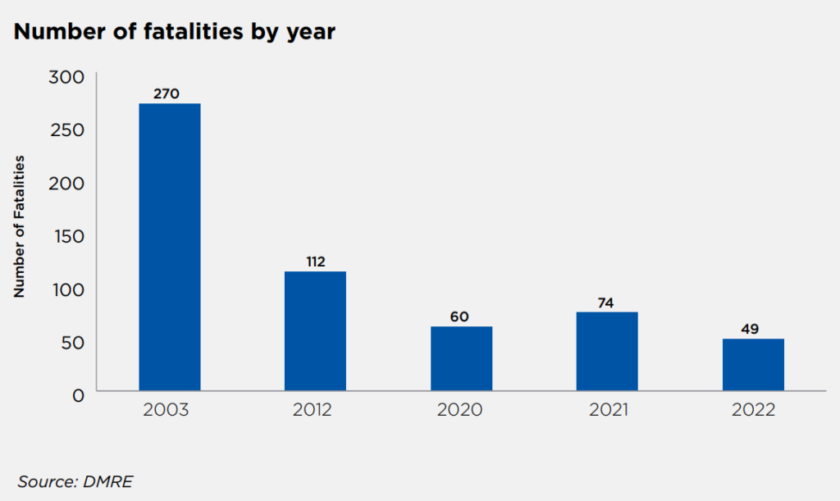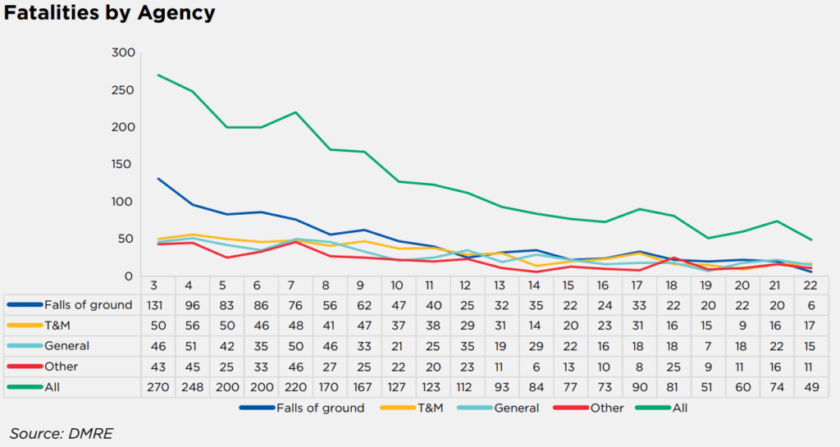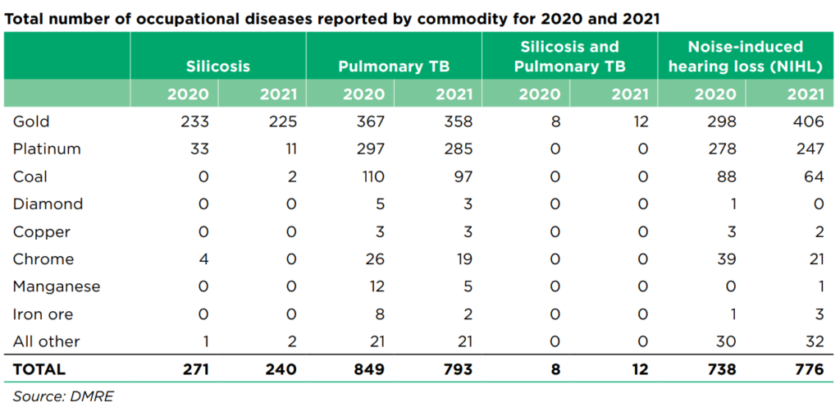The current state of health and safety in South Africa’s mining industry
The Minerals Council Facts & Figures 2022 pocketbook states there has been dramatic improvement in health and safety performance recorded during 2022 for the first time in its history, the South African mining industry has recorded less than 50 lives lost in a calendar year.
The mining industry’s health and safety performance in 2022 showed a marked reduction to below 2019’s 51 lost lives, which was the lowest on record. Provisional statistics indicate that 49 employees lost their lives in 2022, compared to 74 in 2021.
The 2022 safety performance bears testimony to the hard work and dedication of all stakeholders in the mining industry towards ensuring the safest possible working conditions in South Africa’s mines to achieve zero harm.
The heightened focus on safety halted and reversed the two-year regression in safety as the Minerals Council and its members urgently addressed the unacceptable safety performance of the industry during and immediately after the COVID-19 pandemic in 2020 and 2021.
The many collaborative initiatives by the Board of the Minerals Council and the mining industry’s leadership through the CEO Zero Harm Forum had a significant impact in the operational safety of member companies.
The Minerals Council called an urgent Board meeting in September 2022 to revitalize safety interventions after a worrying regression in August.
The year-on-year reduction in the loss of life is 34%. The platinum and gold sectors were the highest contributors to the overall loss of life with 17 and 16 deaths in 2022 respectively.
This is also the first time that the loss of lives in another sector exceeded the number of lives lost in the gold sector. The coal sector recorded 6 deaths while the other commodities accounted for 10 deaths. All sectors reduced their loss of lives by between 15% and 43%, with the gold sector having the biggest reduction of 43%.
An analysis of the loss of life trends indicates that the number of deaths resulting from falls of ground has shown a marked 73% reduction to 6 in 2022. Transportation and Machinery is the only area that saw a regression, with 17 deaths compared to 16 in the previous year.
The Minerals Council Board and the CEO Zero Harm Forum continue to monitor the progress on the Trackless Mobile Machinery project that will address transport-related incidents.
The industry continued to implement several “low-hanging fruit” with a focus on traffic flow and risk analysis. The Fall of Ground Action Plan approved by the Minerals Council Board and the CEO Zero Harm Forum in July 2021 has delivered encouraging results.
The programme has six pillars which include the adoption of new leading practices aimed at minimising uncontrolled rock damages, underground visibility and eliminating the risk of working under unsupported rock, skills development related to rock engineering, including the updating of learning material for the Chamber of Mines Strata Control Certificate and Rock Mechanics Certificates.

The need for more research and development (R&D) related to barring technology, seismic hazard rating and support designs forms part of the pillar under R&D. The Fall of Ground Action Plan includes an investment of R46 million over five years.
Reduction in injuries
The industry recorded an 8% reduction in serious injuries with a total of 1,946 compared to 2,123 in 2021. The gold sector has shown the most improvement with a reduction of 25% whilst the platinum sector saw a 1% reduction in serious injuries. Coal and other commodities regressed by 1% and 11% respectively.

Occupational disease, tuberculosis (TB) and HIV Statistics
There continues to be a reduction in the occupational diseases reported both to the DMRE and to the Minerals Council. All mines report annually to the DMRE on occupational diseases, TB and HIV. The Minerals Council has an Occupational Health Reporting System where any company can report on the Mine Health and Safety Council milestones for 2024 as well as the indicators set by the Masoyise Health Programme. Statistics from both organisations are reported on.

Occupational diseases reported to the DMRE
Reports from all mines showed a decrease of 4.2% in the total number of occupational diseases reported by mines, from 2,013 cases in 2020 to 1,924 cases in 2021.
TB and silicosis declined by 6.6% and 11.4% respectively while noise induced hearing loss (NIHL) increased by 5.1%. There are significant numbers of NIHL cases reported in the industry. TB and HIV reported to DMRE for 2021 Mines are required to report on TB and HIV, and for the 2020/21 financial year 789 mines reported, representing approximately 460,000 employees.
This is compared to 775 mines that reported with approximately 453,000 employees in 2019/2020. HIV counselling and TB screening regressed from 73.5% and 93.3% in 2020 respectively. This is most likely due to the impact of COVID-19 on health services.
Occupational diseases, TB, and HIV reported to Minerals Council.
Through the Minerals Council’s flagship Masoyise Health Programme, performance against the industry occupational health milestones is monitored and it is reported on below.
In 2021, 114 companies representing 397,820 employees registered on the Minerals Council Occupational Health Information Management System. This accounted for 394 mines in South Africa, which represent about 86.5% of the estimated 460,000 employees in the mining industry.
SOURCE:miningreview.com
111 total views , 1 views today





